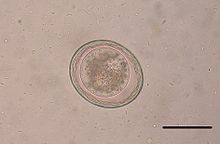| Toxascaris leonina Temporal range:
Late Pleistocene – present (~16,800–0 YBP)[1] | |
|---|---|

| |
| A canine roundworm (Toxascaris leonina) egg. | |
| Scientific classification | |
| Kingdom: | |
| Phylum: | |
| Class: | |
| Order: | |
| Family: | |
| Genus: | |
| Species: | T. leonina
|
| Binomial name | |
| Toxascaris leonina | |
| Type species | |
| T. leonina | |
Toxascaris leonina is a common parasitic roundworm found in dogs, cats, foxes, and related host species. T. leonina is an ascarid nematode, a worldwide distributed helminth parasite which is in a division of eukaryotic parasites that, unlike external parasites such as lice and fleas, live inside their host.[2] The definitive hosts of T. leonina include canids (dogs, foxes, etc.) and felines (cats), while the intermediate hosts are usually rodents, such as mice or rats. Infection occurs in the definitive host when the animal eats an infected rodent. While T. leonina can occur in either dogs or cats, it is far more frequent in cats.[3]
A coprolite containing T. leonina eggs was excavated in Argentina's Catamarca Province and dated to 17002–16573 years old. This finding indicates that T. leonina has existed in South America since at least the Late Pleistocene.[1]
- ^ a b Petrigh, R. S.; Martínez, J. G.; Mondini, M.; Fugassa, M. H. (2019). "Ancient parasitic DNA reveals Toxascaris leonina presence in Final Pleistocene of South America". Parasitology. 146 (10): 1284–1288. doi:10.1017/S0031182019000787. hdl:11336/177873. PMID 31196226.
- ^ Maizels RM, Yazdanbakhsh M (2003). "Immune regulation by helminth parasites: cellular and molecular mechanisms" (PDF). Nat. Rev. Immunol. 3 (9): 733–44. doi:10.1038/nri1183. hdl:1842/465. PMID 12949497. S2CID 9323279.
- ^ "Roundworms in pets, Vet PetStop, UK". Archived from the original on 2009-05-25. Retrieved 2009-07-05.